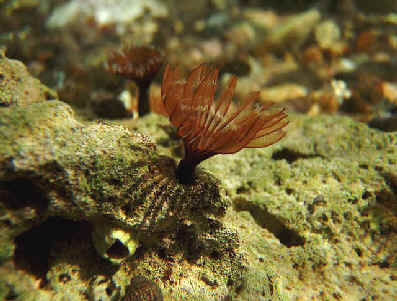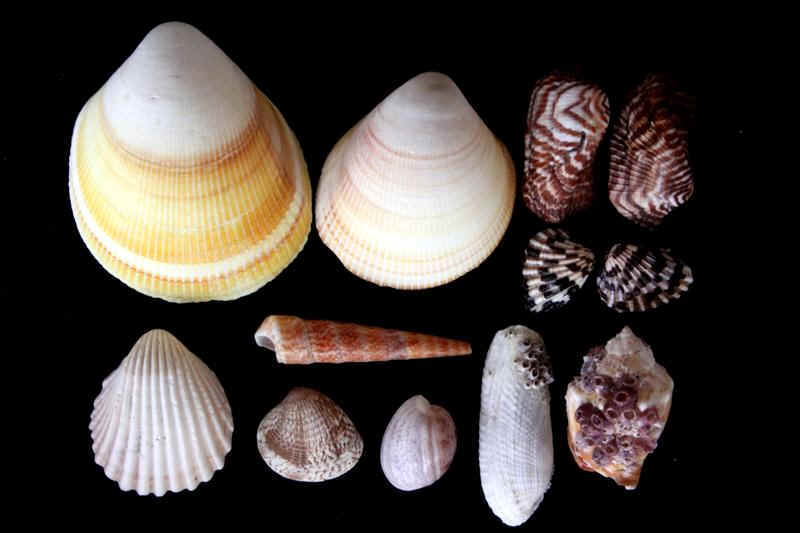 Some
MARINE LIFE
Some
MARINE LIFE
of Western North America
of the Pacific Ocean
& Gulf of California
(other than Whales & Dolphins)
including inshore & offshore waters
and coastal Alaska, Washington State,
California. & Sonora, Mexico
A list compiled by Armas Hill
With those seen during FONT tours
& pelagic trips
with an (*)
Photo at upper
right: a SEA FAN on the coral PORITES CALIFORNICA,
in the Gulf of California, also known as the Sea of Cortez,
in Sonora, Mexico
Links:
A
Listing of scheduled Focus On Nature Tours
Upcoming
Focus On Nature Tours in North America
FONT
Past Tour Highlights
Links, in the following list, to:
Sea
Turtles
Fish
(including Sharks & Rays)
Corals
& Jellyfish
Mollusks (Shells)
Anthropods
(incluidng Crustaceans & Echinoderms)

Codes:
Seen during FONT tours & pelagic trips in the following:
AK: in
Alaska
CA: in California
SN: in Sonora, Mexico (the Gulf of
California, or Sea of Cortez)
WA: in Washington State
(p): seen pelagically
Species with a PR occur in the area of Point Reyes,
California.
MARINE, or SEA, TURTLES
(Reptiles)
- Leatherback (Sea) Turtle (*)
______ CA
Dermochelys coriacea
The Leatherback Sea Turtle is the world's largest turtle. It can weigh half a
ton. A deep
diver, it can go to a depth of about 5,000 feet.
Leatherback Sea Turtles, of the now-rare Pacific population,
have been seen (adult females & hatchlings) during FONT Tours in Costa
Rica in December/January at one of their night-time nesting sites, at a
beach in the region of that country known as Guanacaste.
FISH:
PLANKTON-FEEDING SHARKS & RAYS
REQUIEM SHARKS (Family Carcharhinidae)
- Blue Shark (*) ______ CA
Prionace glauca
THRESHER SHARKS (Family Alopiidae)
- Thresher Shark (*) ______
CA (p)
Alopias vulpinus
SALMONS (Family Salmonidae)
- Chinook (also called
King Salmon) (*) ______ WA
Oncorhynchus
tshawytscha
SEAHORSES (in Family Syngnathidae, along with Pipefishes)
- Common Seahorse (*) ______ MX
Hippocampus ramulosus
INVERTEBRATES
including those of the OPEN OCEAN:
CNIDARIANS
(including corals & jellyfish)
STONY CORALS (Class Scleractinia)
- Northern Stony Coral ______ NC
391
Astrangia danae
JELLYFISH (Class Scyphozoa)
- Moon Jelly (*) ______ CA,DE,NJ
(p)
Aurelia aurita
- Cannonball Jellyfish (*)
______ TX
Stomolophus meleagris
HYDROIDS (Class Hydrozoa, Order Siphonophora: not true jellyfish)
- Portuguese Man-of-war (*)
______ NC,NJ (p)
Physalia physalis
MOLLUSKS (SHELLS)
SEASHELLS are made by MOLLUSKS.
MOLLUSKS are invertebrate animals that produce shells of one or two pieces
that wholly or partially enclose a soft body.
SHELLS are the skeletons of MOLLUSKS. Like the internal skeleton
(endoskeleton) of a mammal, the external skeleton (exoskeleton) of mollusks
function both for protection and as a place for muscle attachment.
A SHELL found on a beach is the skeletal remnant of a dead MOLLUSK.
MOLLUSKS are either snail-like animals with one shell (UNIVALVES, or
GASTROPODS), or clam-like animals with two shells (BIVALVES). The two
shells of a BIVALVE are held tightly together when the animal is alive.
A third group of MOLLUSKS are the CEPHALOPODS, including SQUIDS and
OCTOPUSES. These animals lack external shells, having instead internal or
rudimentary shells.

Shells collected along the shoreline of the Gulf of
California
during the FONT Tour in Sonora, Mexico in August 2010
GASTROPODS (Class Gastropoda): snail-like mollusks with a one-part
shell
- Red Abalone ______ PR
Haliotis rufescens
- Black Abalone ______ PR
Haliotis cracherodii
- Rough Keyhole Limpet ______ PR
469
Diodora aspera
- Volcano Limpet
______ PR
Fissurella volcano
- Giant Keyhole
Limpet ______
Megathura crenulata
- Seaweed Limpet
______ PR
Notoacmaea incessa
- Plate Limpet
______ PR
Notoacmaea scutum
- Shield Limpet
______
Collisella pelta
- Owl Limpet ______ PR
Lottia gigantea
- Purple-ringed Top Snail ______
Calliostoma annulatum
- Red Top Snail
______ PR
Astraea gibberosa
- Black Turbin Snail
______ PR
Tegula funebralis
- Eroded Periwinkle
______ PR
Littorina planaxis
- Sikta Periwinkle
______
Littorina sitkana
- Checkered Periwinkle ______ 479
Littorina scutulata
- Scaled Worm Snail ______
Serpulorbis squamigerus
- Greenland Wentletrap ______
Epitonium greenlandicum
- Common Slipper Snail ______ 487
Crepidula fornicata
- Chestnut Cowrie
______
Cypraea spadicea
- Oregon Hairy
Triton ______
Fusitriton oregonensis
- Angular Unicorns
______ PR (also called Unicorn Whelk)
Acanthina spirata
- Checkered Unicorn
______
Acanthina paucilirata
- Spotted Unicorn
______
Acanthina punctulata
- Leafy Hornmouth
______
Ceratostoma foliatum
- Emarginate Dogwinkle
______
Nucella emarginata
- Poulson's Rock
Snail ______
Roperia poulsoni
- Atlantic Oyster Drill ______ PR 499
Urosalpinx cinerea
- Corded Neptune
______
Neptunea lyrata
- Channeled Whelk ______ 503
Busycon canaliculatum
- Giant Western Nassa
______
Nassarius fossatus
- Purple Dwarf Olive
______
Olivella biplicata
- Ida's Miter ______
Mitra idae
- California Cone
______
Conus californicus
- California Bubble
______
Bulla gouldiana
- White Paper Bubble
______
Haminoea vesicula
- California Sea
Hare ______ PR (also called Brown Sea Hare)
Aplysia californica
- Navanax ______
Chelidonura inermis
- Hairy Doris ______
Acanthodoris pilosa
- Sea Lemon ______ PR
Anisodoris nobilis
- Pacific Ancula
______
Ancula gibbosa
- White Knight Doris
______
Archidoris odhneri
- Monterey Doris
______
Archidoris montereyensis
- Yellow-edged Cadlina
______
Cadlina luteomarginata
- Ringed Doris
______
Dianlula sandiegensis
- Salted Doris
______
Doriopsilla albopunctata
- Hopkin's Rose
______
Hopkinsia rosacea
- Blue-and-gold Nudibranch
______
Hypselodoris californicus
- Rough-mantled
Doris ______
Onchidoris bilamellata
- Crimson Doris
______
Rostanga pulchra
- Sea Clown Nudibranch
______
Triopha catalinae (formerly T. carpenteri)
- Spotted Triopha
______
Triopha maculata
-
- Common Atlantic Auger ______ NC 515
Terebra dislocata
BIVALVES (Class Bivalva)
- Turkey Wing ______ NC 534
Arca zebra
- Blue Mussel ______ NC 538
Mytilus edulis
- Stiff Pen Shell ______ NC 540
Atrina rigida
- Saw-toothed Pen Shell ______ NC
541
Atrina serrata
- Kitten's Paw ______ NC 541
Plicatula gibbosa
- Atlantic Bay Scallop ______ NC
542
Argopecten irradians
- Common Jingle Shell ______ NC
546
Anomia simplex
- Eastern Oyster ______ NC 547
Crassostrea virginica
- Giant Atlantic Cockle ______ NC
556
Dinocardium robustum
- Northern Quahog (Clam) ______
NC 559
Mercenaria mercenaria
- Coquina ______ NC 566
Donax variabilis
- Common Razor Clam ______ NC
569 (also called Atlantic Jackknife Clam)
Ensis directus
- Surf Clam ______ NC 569
Spisula solidissima
- Angel Wing ______ NC 573
Cyrtopleura costata
SQUIDS & OCTOPODS (Class Cephalopoda)
- Common Atlantic Octopus ______ 579
Octopus vulgaris
ANTHROPODS
(Class Merostomata)
- Horseshoe Crab ______ DE,NC 586
Limulus polyphemus
CRUSTACEANS
- Striped Hermit Crab ______ NC
627
Clibanarius vittatus
- Acadian Hermit Crab ______ 629
Pagurus acadianus
(range: Labrador to the Chesapeake Bay)
- Long-clawed Hermit Crab ______
NC 631
Pagurus longicarpus
The Long-clawed Hermit Crab is the most common hermit crab
along the Atlantic Coast. It normally uses the shells of the periwinkle,
mud snail, or oyster drill.
- Flat-clawed Hermit Crab ______
NC 631
Pagurus pollicaris
The Flat-clawed Hermit Crab is often found in the shells of Moon
Snails and the larger whelks.
- Sargassum Crab (*) _____
638 NC (p) (normally a creature of the high seas & a
member of the Sargasso Weed community)
Portunus sayi
- Blue Crab ______ NC 639
Callinectes sapidus
- Ghost Crab ______ NC 653
Ocypode quadrata
- Sand Fiddler ______ NC 654
Uca pugilator
- Brackish-water Fiddler ______
NC 655
Uca minax
ECHINODERMS
ASTEROIDS (Class Stelleroidea): including
the sea stars and brittle stars
"Sea Star" is preferred to "Star Fish" as that term is a
misnomer as "fish" are finny vertebrates.
- Forbes' Common Sea Star
______ NC 679
Asterias forbesi
(Class Echinoidea):
including sea urchins and sand dollars
- Atlantic Purple Sea Urchin
______ NC 689
Arbacia punctulata
- Variegated Urchin ______ NC 690
Lytechinus variegatus
- Keyhole Urchin (or Keyhole Sand
Dollar) ______ NC 695
Mellita quinquiesperforata
References include:
"Sea Life - A Complete Guide to the Marine Environment", edited by
Geoffrey Waller, with principal contributors Marc Dando & Michael Burchett,
1996.
"Nature in the Northwest - An Introduction to the Natural History and
Ecology of the Northwestern United States from the Rockies to the Pacific",
by Susan Schwartz, 1983.
To Top of
Page



 Some
MARINE LIFE
Some
MARINE LIFE![]()
